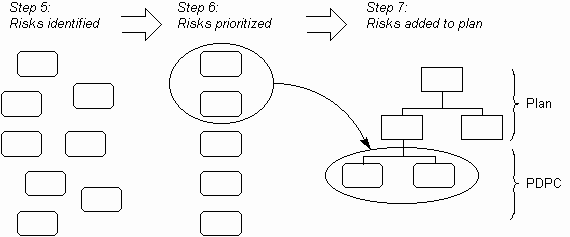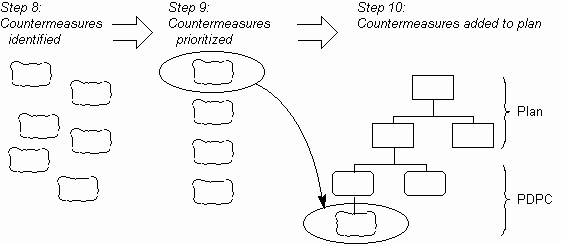Process Decision Program Chart (PDPC): How to do it
The Quality Toolbook >
Process Decision Program Chart (PDPC) > How to do it
When to use it | How to understand it |
Example | How to do it | Practical
variations
<-- Previous |
Next -->
How to do it
- Identify the objective of using PDPC. For example, 'To identify risks in a specific area of a plan, and to identify countermeasures where the cost of the risk occurring is greater than a certain figure'.
Ensure that the situation merits the use of PDPC. This will usually be when risks are either unknown or may have serious consequences if they occur.
The plan should be available and complete, unless the PDPC activity is being used as an integral part of the planning process.
- Identify the areas of the plan which need to be examined in order to meet the objectives. If it is a large plan, then attempting to examine all elements of it will result in a practical limitation on the effort that can be put into each element. It is usually better to use PDPC only on the higher risk areas of the plan.
- Gather the people to work on the PDPC. Between them, they should have as wide a view as possible of the situation, so that diverse risks may be identified. These may include:
-
High-level managers who can see the 'big picture' and relationships with other people and events. -
Experts in specific elements of the plan who can see potential problems with planned actions. -
People experienced in planning and using PDPC, who may have discovered other problems in similar situations.
- Identify the criteria for making decisions during construction of the PDPC. These include:
-
How to identify a risk (step 5). For example, 'Something that has a significant effect on the schedule completion time'.
-
How to select risks that need countermeasures to be identified (step 6). For example, 'The top 10% of identified risks and also those for which simple countermeasures are obvious'.
-
How to identify countermeasures (step 7). For example, 'A measure that has a good chance of reducing the identified risk'.
-
How to select countermeasures to implement (step 8). For example, 'Those which cost less than the savings they would make if they were implemented'.
Factors to consider when identifying selection criteria include:
- Time
. How much time would a risk cost? Is it on the critical path of the schedule? How much time could countermeasures save?-
Cost. What would be the overall cost of a risk occurring? What would be the cost of a countermeasure? Would it be worth it?
-
Control. How much control do you have for preventing the risk? What control would you have should it occur? How could you change that?
-
Information. How much do you know about the risk? What warning would you have of its impending occurrence?
- For each plan element to be considered, identify potential problems that could occur. Ask, 'What if ...', using Brainstorming techniques to identify a broad range of risks. This can be helped by using a checklist of questions to ask.
These risks can either be written down in a separate list or on 3" x 5" cards that can be moved about during step 6. Cards are particularly useful if larger numbers of risks are being identified or if the PDPC is being done as a part of a planning session which is also using cards.
- For the risks identified in step 5, decide which ones should be carried forward onto the PDPC. These will be examined in more detail when determining countermeasures in step 8. This may be carried out by Voting, Prioritization Matrix or some other method for selecting items.
To keep the PDPC manageable, select only a few risks per plan element (typically three or less).
- Put the identified risks on the plan, using shaped boxes or some other method to enable these risks to be clearly differentiated from then plan elements. Steps 5 to 7 are illustrated below.

Fig. 1. From risks to PDPC
- For each risk now on the PDPC, identify possible countermeasures in a similar manner to the identification of risks in step 5, but now asking, 'How can this risk be reduced?'. Look for methods of eliminating, reducing or handling the risk.
- In a similar manner to step 6, prioritize these countermeasures and select those which are to be carried forward to the PDPC, using the criteria determined in step 4.
- In the same way as step 7, add the selected countermeasures to the plan under the appropriate risk item. Steps 8 to 10 are illustrated below.

Fig. 2. Adding Countermeasures
- Carry out or otherwise prepare the selected countermeasures, ensuring that any changes to the plan are fully resourced and are treated thereafter as normal plan elements. Actions here might include:
- Changing the plan, e.g. to remove or replace high risk elements.
- Adding new elements to the plan, e.g. verification activities.
- Preparing contingency plans which will only be executed should specific risks occur.
<-- Previous |
Next -->
|